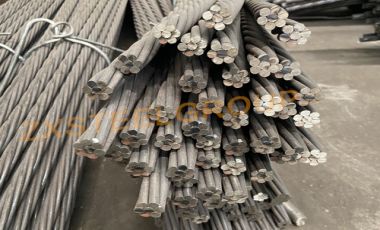
Using a 17.8mm cable bolt for mine support is a critical aspect of underground mining operations. Cable bolts, also known as rock bolts, are essential for stabilizing rock masses and ensuring the safety of miners. They provide reinforcement to the surrounding rock, preventing collapses and maintaining the integrity of the mine. In this guide, we'll delve into the process of using a 17.8mm cable bolt for mine support.
1. Selection of the Right Cable Bolt:
The first step is to choose the appropriate cable bolt for your mine. In this case, you have a 17.8mm diameter cable bolt. Ensure it meets the strength and durability requirements for your specific mine conditions.
2. Drilling the Hole:
Drill a hole into the rock mass at the desired location for support. The hole's diameter should match the cable bolt size, in this case, 17.8mm. The depth and angle of the hole will depend on the specific mine design and geological conditions.
3. Cleaning the Hole:
After drilling, it's crucial to clean the hole thoroughly to remove any loose debris or cuttings. This ensures proper contact between the cable bolt and the rock, maximizing its anchoring capacity.
4. Inserting the Cable Bolt:
Thread the 17.8mm cable bolt into the hole. It's essential to make sure the entire length of the bolt is inside the hole for proper anchoring. The protruding end is typically capped with a steel plate or other hardware for added stability.
5. Grouting:
Depending on the mine's requirements, you may need to grout the hole. Grouting involves injecting cementitious materials into the hole to secure the cable bolt in place and create a strong bond with the surrounding rock. Grouting enhances the cable bolt's load-bearing capacity and longevity.
6. Tensioning the Cable Bolt:
To achieve the desired rock support, tension the cable bolt using an appropriate tool or machine. The tension applied depends on the rock conditions and the mine's design specifications. Ensure the bolt is adequately tensioned to provide the necessary support.
7. Testing and Monitoring:
After installation, it's crucial to conduct regular inspections and load tests to ensure the cable bolt maintains its structural integrity and meets safety standards. This ongoing monitoring is vital for mine safety.
8. Maintenance and Replacement:
Over time, cable bolts may deteriorate due to factors such as corrosion or stress. It's essential to establish a maintenance schedule and replace cable bolts when necessary to maintain mine safety and stability.
9. Compliance with Safety Regulations:
Always adhere to mine safety regulations and guidelines when using cable bolts. Compliance with safety standards is essential to protect mine workers and maintain the structural stability of the mine.
10. Documentation:
Maintain detailed records of cable bolt installations, maintenance, and testing. Proper documentation ensures accountability and helps in case of any incidents or accidents.
11. Training and Skill Development:
Ensure that mine personnel responsible for cable bolt installation and maintenance are adequately trained and possess the necessary skills and knowledge. This minimizes the risk of errors during the process.
12. Adaptation to Changing Conditions:
Mining conditions can change over time, and cable bolt installations may need to be adjusted accordingly. Regularly assess the effectiveness of cable bolt support and adapt as needed to accommodate changing geological conditions.
In conclusion, using a 17.8mm cable bolt for mine support is a critical practice in underground mining operations. Proper selection, installation, maintenance, and monitoring of cable bolts are essential for mine safety and the overall stability of the mine. By following these guidelines and adhering to safety regulations, miners can ensure a safer and more stable working environment.
Address: No. 1738, 17th Floor, No. 1 Mall, Shangdu Road, Zhengdong New District, Zhengzhou City, Henan Province, China
Email: zxminesupport@zxsteelgroup.com
Tel: +86-199 3712 3680
© 2020 ZXSTEELGROUP